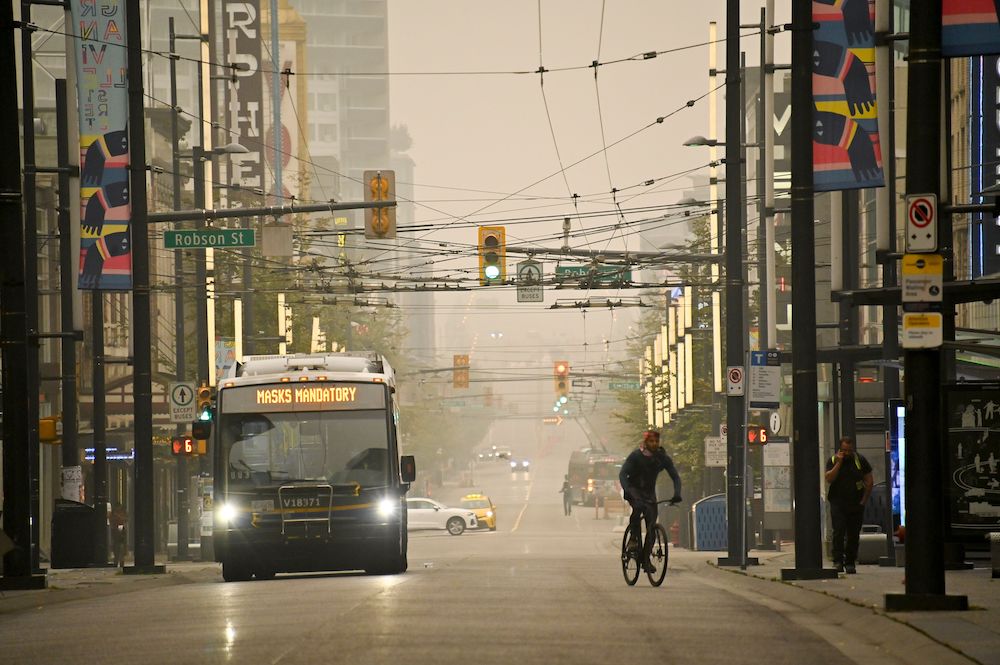Air quality in Canada has improved over the past several decades, and Canada’s air is among the cleanest in the world. But that progress is threatened by smoke from wildfires, which are becoming more frequent and more intense with climate change.
Canada’s 2023 wildfire season is the worst on record, with more than 5,800 reported fires and over 15 million hectares burned to date.
Globally, air pollution is a leading cause of death and disease. One of the best indicators of health risk from air pollution is the concentration of very small particles called PM2.5 (which stands for particulate matter smaller than 2.5 micrometres).
PM2.5 particles can deposit deep in the lungs and long-term exposure can cause a wide range of health effects including respiratory and cardiovascular disease, diabetes, lung cancer and pregnancy complications. Health effects can occur even at low concentrations, including those below current Canadian Ambient Air Quality Standards.
Wildfires produce enormous quantities of PM2.5 and several other hazardous pollutants. Wildfire smoke can travel long distances, exposing large populations — both close to and far away from fires — to very high concentrations of pollution.
The health impact of wildfire smoke
The pollution mixture and chemical composition of wildfire smoke is often different from the pollution emitted by other sources, and these differences may influence toxicity. The toxicity of wildfire smoke also depends on the type of vegetation and burning conditions, and may change as the smoke “ages” in the atmosphere. This underscores the need to distinguish the health impacts of wildfire smoke from the impacts of other pollution sources.
Evidence linking wildfire smoke with adverse health effects has been accumulating for years and the notion that wildfire smoke is “natural,” and therefore less harmful than other types of air pollution, is not supported by the evidence.
Most studies have evaluated the relationships between daily changes in smoke levels and indicators of health such as emergency department visits, hospital admissions or deaths.
There is strong evidence that these “acute” exposures to wildfire smoke increase the risk of respiratory illness and death, and evidence of effects on the cardiovascular system is also growing. Older adults, people living in low-income areas, and those with asthma, chronic obstructive pulmonary disease, heart disease and other chronic conditions are most susceptible.
The health effects of wildfire smoke likely extend beyond the lungs and heart. Recent studies indicate that exposure during pregnancy may increase the risks of preterm birth and decreased birth weight. Smoke may also reduce attention measured on cognitive tests and increase dementia risk.
More studies are needed, but these effects could have important implications for health during vulnerable stages of life.
Much less is known about the impacts of exposure to wildfire smoke over longer durations or from multiple episodes. As more Canadians are exposed to smoke, and as the duration of the forest fire season increases, it will be critical to understand the long-term health impacts of repeated smoke exposure, especially among the most at-risk populations.
Strategies to protect health
Unlike anthropogenic sources of air pollution, emissions of wildfire smoke cannot be readily controlled at the source. But there are strategies that individuals and communities can use to reduce exposure and health risks.
Before fires begin, those with chronic conditions can discuss strategies for managing their health with their health-care providers, and ensure access to necessary medications. During smoke events, staying indoors can be beneficial because buildings reduce exposure to outdoor-generated pollution when windows and doors are closed.
Correctly sized portable HEPA filter air cleaners can reduce indoor PM2.5 by as much as 80 per cent. And well-fitting N95 respirators (or comparable respirators designed and certified for occupational use) can reduce PM2.5 exposure when outdoors or in transit. The Air Quality Health Index and smoke forecasts can help Canadians decide when these strategies are needed.
These strategies also have limitations. For example, the recommendation to stay indoors assumes that individuals have stable and safe housing. It is also complicated by heat, a major threat to health that may amplify the effects of PM2.5.
Portable air filters are prohibitively expensive for some families, they do not remove the gases found in wildfire smoke, and they will be less effective for those who spend time in other locations, such as outdoor workers. High quality respirators may be unavailable in some communities, may cause discomfort and a good facial fit will be impossible for many children and some adults.
Government and public health agencies can help to offset some of these limitations and ensure more equal protection from smoke by providing accessible and clear messages to the public and establishing clean air shelters in libraries, schools and other public buildings.
Multiple overlapping strategies are needed to mitigate the health impacts of Canada’s worsening wildfires.![]()
![]()
Read more: Health, Environment
















Tyee Commenting Guidelines
Comments that violate guidelines risk being deleted, and violations may result in a temporary or permanent user ban. Maintain the spirit of good conversation to stay in the discussion and be patient with moderators. Comments are reviewed regularly but not in real time.
Do:
Do not: